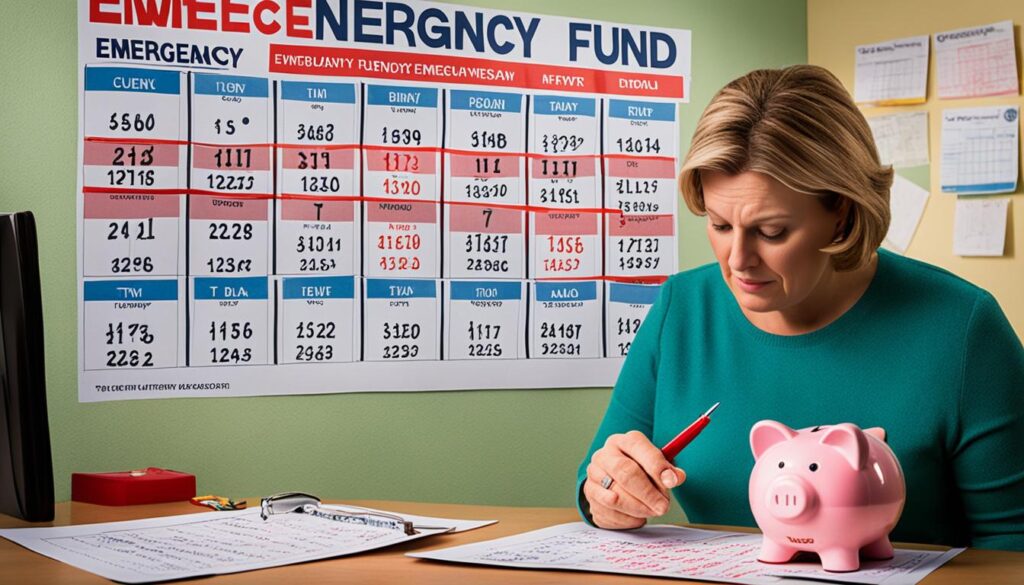Welcome to our detailed financial planning guide! Here, we’ll show you how to create a strong financial future. This article is perfect whether you have short-term aims or seek long-term stability. Let’s get you ready to make smart financial choices.

Let’s start with setting goals. It’s key to outline your short-, intermediate-, and long-term dreams. This helps build a path to success. Are you set to secure your future? Let’s begin!
Key Takeaways:
- Setting short-term financial goals is crucial for building a strong financial foundation.
- Create a budget to track expenses and identify areas where you can save money.
- Build an emergency fund to cover unexpected expenses and provide a safety net.
- Focus on paying off credit card debt to reduce financial burdens.
- Establish midterm financial goals by prioritizing insurance policies and paying off student loans.
Setting Short-Term Financial Goals
Setting short-term financial goals is key to taking control of your money. It helps lay the groundwork for a secure financial future. By making reachable goals and a plan to hit them, you’re on your way to lasting financial health.
Creating a budget: First, make a budget. This lets you see your money flow, showing where you can save and spend wisely. A budget helps you understand your finances better, guiding you to reach your goals.
Building an emergency fund: It’s also critical to have an emergency fund. Unexpected costs, like car fixes or medical bills, can hit any time. Saving a bit of your money each month builds a safety net for these surprises.
Paying down credit card debt: Credit card debt can weigh you down with its high interests. Focusing on reducing this debt can lighten your financial load. By setting up a repayment strategy and putting extra money towards your debt, you can slowly get rid of it, improving your financial situation.
“Setting short-term financial goals is like laying the groundwork for a strong financial future. By creating a budget, building an emergency fund, and paying down credit card debt, you are taking control of your finances and setting yourself up for long-term success.” – Financial Expert
Having clear short-term financial goals lets you make smarter choices and take steps toward financial stability. Creating a budget, building an emergency fund, and paying down credit card debt puts you on the path of meaningful progress in your financial life.
Benefits of Setting Short-Term Financial Goals
Short-term financial goals have many benefits that help improve your finances now. Let’s look at some key perks:
- Increased financial awareness: A budget and short-term goals boost your understanding of your money. You get a clear view of what you earn, spend, and how you can manage your cash better.
- Stress reduction: An emergency fund and less debt can greatly lower stress. Feeling secure financially and moving toward a debt-free life offers peace of mind.
- Improved financial discipline: Short-term goals promote good financial habits. Sticking to a budget and focusing on debt repayment builds discipline that benefits your entire financial journey.
Strategies for Achieving Short-Term Financial Goals
| Goal | Strategy |
|---|---|
| Creating a budget | Track income and expenses, identify areas to save, and prioritize spending. |
| Building an emergency fund | Set aside a portion of income each month, automate savings, and consider decluttering and organizing to make extra money. |
| Paying down credit card debt | Create a repayment plan, allocate extra funds towards debt repayment, and consider debt consolidation or negotiation. |
By setting short-term financial goals and following through with plans, you take charge of your finances. Starting with a budget, an emergency fund for the unplanned, and a debt repayment plan puts you on track for financial achievement.
Establishing a Budget
Creating a budget is key to managing money well and reaching your financial goals. It helps you see your financial status clearly. By doing this, you have the power to spend wisely and save more. Keeping track of spending and using tools like apps are key parts of budgeting.
To start a budget, first figure out your income and your spending categories. Make a list of your monthly expenses, like rent or mortgage, utilities, and food. Don’t forget monthly subscriptions, as their costs can quickly add up.
It’s important to keep an eye on where your money goes. Mint is a great app for this. It links to your accounts and sorts your expenses for you. Mint shows you how much you’re spending in areas like food, clothes, or travel. This helps you spend smarter and manage your money better.
Regular expense tracking helps spot and fix budget issues. Maybe you find you’re eating out too much. Cooking at home more can save money. Or, you might notice too much shopping. Cutting back on this can keep your budget in check.
Watching your spending can really open your eyes. You learn where your money goes and how to make better spending choices.
Budgeting and tracking expenses help you meet your financial dreams. It guides you whether you’re saving for a house, a vacation, or to pay off debts. A budget shows you how to get there.
Start your journey to financial health with a budget. Use tools like Mint to watch your spending. This gives insights into spending patterns, shows where to save, and leads to a secure financial future.
| Benefits of Establishing a Budget |
|---|
| Provides a clear understanding of your financial situation |
| Helps you make informed decisions about spending |
| Identifies areas where you can save money |
| Allows you to track expenses and adjust accordingly |
| Paves the way for achieving your financial goals |
Learning to budget and monitor spending is vital for financial strength. With hard work and regular effort, you can master your finances and aim for a wealthier life.

Building an Emergency Fund
An emergency fund is key to a stable financial plan. It’s like a safety net for surprise costs. With this fund, you know you’re covered for life’s unexpected events.
Begin with saving **$500 to $1,000**. This goal is achievable for most and a good starting point. Over time, aim to save enough to cover **3 to 6 months’** expenses. This helps you through tough financial times.
Setting up automatic transfers helps grow your emergency fund. It makes saving consistent and easy. Just transfer money regularly from your checking to savings account.
Selling things you no longer need can also boost your fund. Look around your home and sell what you don’t use. Use online platforms or local markets to make extra money.
An emergency fund gives you financial safety and peace of mind. It’s crucial for handling surprises. To build it, **save for the unexpected**, **set up automatic transfers**, and **sell unneeded items**.
| Creating an Emergency Fund | |
|---|---|
| Benefits | An emergency fund provides a safety net for unexpected expenses. |
| Saving Goal | Start by saving $500 to $1,000 and gradually increase to cover 3 to 6 months’ worth of expenses. |
| Automatic Transfers | Set up recurring transfers from your checking account to ensure consistent contributions to your emergency fund. |
| Decluttering and Organizing | Sell unused items to generate extra cash that can be directed towards your emergency fund. |
Creating an emergency fund is crucial for your financial health. Proactively saving helps you stay prepared for any surprises. It ensures you’re set for a secure financial future.

Paying Off Credit Cards
Paying off credit card debt is key to financial stability. High-interest rates and small payments can trap you in debt. This stops you from saving and investing for the future. It’s time to take action and eliminate those credit card debts.
The Debt Avalanche Method
The debt avalanche method is a smart way to pay off credit card debt. It focuses on clearing high-interest debts first. This saves you money on interest over time.
“With the debt avalanche method, you tackle the highest interest rate card first. Make minimum payments on the rest. When the highest debt is gone, move to the next one. This strategy helps you cut down your overall debt fast.”
The Debt Snowball Method
The debt snowball method is another effective strategy. It focuses on paying off small debts first. This can give you a sense of accomplishment and keep you motivated.
“The debt snowball method starts with your smallest debts. As you clear each one, you feel more confident. This boost helps you tackle bigger debts with momentum.”
Both the avalanche and snowball methods have pros and cons. Choose the one that matches your financial goals and preferences.
Debt Negotiation and Bankruptcy
If you’re overwhelmed by credit card debt, consider debt negotiation. This means talking to creditors to lower your debt or arrange a better payment plan.
Be cautious with debt negotiation. It’s wise to seek help from a credit counseling agency or advisor. They can offer valuable advice throughout the process.
Bankruptcy is a last resort. It offers relief from debt but harms your credit score. Always talk to a bankruptcy attorney to understand the consequences first.
Paying off credit card debt requires persistence and a solid plan. Celebrate your milestones and seek professional advice when necessary. With time, you can achieve debt freedom.

Table 5: Debt Payoff Strategies Comparison
| Method | Description | Advantages | Disadvantages |
|---|---|---|---|
| Debt Avalanche | Pay off high-interest debts first | Saves money on interest payments | May take longer to eliminate smaller debts |
| Debt Snowball | Pay off smaller debts first | Provides motivation and momentum | May result in higher overall interest payments |
| Debt Negotiation | Negotiate with creditors to reduce debt | May result in lower payments | Could negatively impact credit score |
| Bankruptcy | Legal process to alleviate debt | Can provide a fresh start | Significant impact on credit and financial reputation |
Setting Midterm Financial Goals
Creating a strong financial plan is key. It’s important to set goals. These help you move from short-term to long-term plans. Such goals are crucial for future stability and security.
As you move through your financial journey, think about these goals:
- Life Insurance: Get life insurance to protect your loved ones. It acts as a safety net for unforeseen events. It helps cover debts, mortgage, and future education costs.
- Disability Income Insurance: Consider disability income insurance to protect your earnings. If you become unable to work, it helps you keep up with your financial needs.
- Paying off Student Loans: Focus on repaying student loans to reduce your expenses. Create a solid plan for this debt through aggressive payments or refinancing.
Planning for the future means protecting yourself, ensuring financial stability, and avoiding obstacles. Set goals like getting life insurance, disability insurance, and repaying student loans. These steps will help secure your financial future.

| Midterm Financial Goals | Actions |
|---|---|
| Life Insurance | Look into different life insurance providers. Compare their policies. Choose a plan that fits your needs and budget. |
| Disability Income Insurance | Talk to insurance experts to find the right coverage and policy options for you. |
| Paying off Student Loans | Make a repayment plan. This should include how to budget, loan forgiveness programs, and when to consider refinancing. |
By focusing on these midterm goals, you’re on your way to financial security. You’ll have peace of mind with a solid plan for life’s expected and unexpected events.
Creating a Budget and Stick to It
Managing your money well starts with making a budget. It involves tracking your spending, setting aside money for needs, and setting limits. This helps you take charge of your money and secure your future.
- Budgeting: Start by checking your income and expenses carefully. Find where you can save and set realistic limits for spending on things like food, travel, and fun.
- Tracking Spending: Write down all your expenses to see where your money goes. Mobile apps or online tools can help you track and understand your spending patterns.
- Spending Limits: Based on your upcoming needs and bills, plan your budget. Make sure you have enough for important expenses.
Staying within your budget takes discipline and smart choices. By focusing on your financial goals and spending wisely, you can avoid overspending and stay stable financially.
“A budget is telling your money where to go instead of wondering where it went.” – Dave Ramsey
A budget gives you power over your money. It helps you aim for financial health. This way, you can save for later and keep a tight rein on your spending.

The image above shows how budgeting lets you monitor and control your expenses. This ensures your money is spent the right way.
Create Your Own Budgeting Table
| Expense Category | Amount Allocated | Actual Spending | Difference (Over/Under) |
|---|---|---|---|
| Groceries | $300 | $280 | +$20 |
| Transportation | $200 | $230 | -$30 |
| Entertainment | $100 | $150 | -$50 |
| Utilities | $150 | $150 | $0 |
| Housing | $800 | $800 | $0 |
| Debt Repayment | $200 | $200 | $0 |
| Savings | $400 | $400 | $0 |
| Total | $2,150 | $2,210 | -$60 |
The table above is a good example of how to budget. It compares planned spending with real spending. It helps find where you’re spending more or less than you planned.
Remember, making a budget is only the first step. For ongoing financial health, keep checking and adjusting your budget. It should match your changing financial goals and needs.
Saving for the Future
Saving for the future is essential for long-term stability. It helps you get ready for big costs, create an emergency fund, and hit your financial targets. Starting a habit of saving allows you to grow a large sum over time.
Here are some key methods to save for what’s ahead:
1. Budgeting
It’s vital to create and follow a budget for savings success. First, review your monthly income and spending. Find places to spend less and set money aside for savings. Tracking your expenses and sticking to a budget lets you understand your finances and save better.
2. Establishing a Savings Habit
Begin a savings habit by saving a certain amount from every paycheck. Think of your savings like a bill that must be paid. Doing this often will set a strong financial base and help you reach your long-term dreams.
3. Additional Savings Opportunities
Regularly check your budget to find extra saving chances. Explore ways to lower costs or spend less. Maybe negotiate bills, use discounts, or rethink your living space. Even small savings can grow big over time.

“The habit of saving is itself an education; it fosters every virtue, teaches self-denial, cultivates the sense of order, trains to forethought, and so broadens the mind.”
– Thomas T. Munger
Remember, saving is a journey that needs discipline and effort. Begin with little steps and aim to save more as you proceed. By taking regular actions and keeping your financial goals in sight, you’re on your way to a stable and brighter future.
| Savings Tips | Benefits |
|---|---|
| Create a separate savings account | Earmark funds specifically for saving |
| Automate your savings | Consistently contribute without effort |
| Take advantage of employer matching programs | Double your contributions through employer matching |
| Reduce discretionary spending | Free up more money to put towards savings |
| Invest your savings | Grow your savings through investment returns |
Reducing Debt
Lowering your debt is key to financial health. By paying off what you owe, you gain control over your money. This leads to a brighter financial future.
Make Timely Payments
Making payments on time is essential for lowering debt. It helps you avoid extra fees and boosts your credit score. Set reminders or auto-pay to never miss a payment.
Debt Avalanche or Debt Snowball?
You can choose between two methods to pay off multiple debts: debt avalanche or debt snowball.
With the debt avalanche method, you pay debts with high interest first. Pay the minimum on others. This way, you save money on interest over time.
The debt snowball method has you pay off smaller debts first. This approach lets you see progress quickly. It helps keep you motivated to pay off more debt.
Consider Debt Negotiation or Settlement
If your debt feels too much, consider negotiating. You can talk to creditors or hire a debt settlement company. But think carefully, as this can impact your financial future.
Bankruptcy: A Last Resort
Think of bankruptcy as the last option. It affects your credit and future deeply. Before choosing this, talk to a bankruptcy lawyer to understand all effects.
Reducing debt requires time and dedication. Keep going, stick to your plan, and get advice if needed. By making wise decisions, you can achieve a debt-free life.

Investing Wisely
Investing wisely is key for meeting your long-term money goals. You should think about different investments like stocks, bonds, and real estate. Knowing your risk tolerance and goals is vital. This helps you choose where to put your money. Understanding how you feel about market changes shapes your strategy.
Diversification is crucial in smart investing. By spreading your investments, you can manage risk better. This means less chance of losing money if one investment dips. Invest in stocks, bonds, and real estate for a balanced mix. This could help your money grow over time.
Before you invest, do your homework. Learn about market trends and the history of what you want to invest in. This helps make choices that fit with your goals. And it might help avoid bad investments.
Types of Investment Options
“The stock market allows individuals to invest in publicly-traded companies, presenting an opportunity for long-term growth and potential dividends.”
– John Smith, Financial Advisor
Stocks mean you own part of a company. They can grow over time and might pay dividends. But remember, stocks can be unpredictable. Their worth depends on how the company does and market conditions.
Bonds are like lending money to a company or government. You get interest back and the original money lent. Bonds are usually less risky than stocks. They could give your investment stability.
Mutual Funds gather money from many investors. This money goes into stocks, bonds, or other assets. Managed by professionals, they’re good for those who prefer not managing their investments directly. Mutual funds offer diversification and professional management.
Real Estate is another long-term investment option. It can provide rental income and increase in value over time. You can directly own property, invest in REITs, or try crowdfunding in real estate.

Maximizing Returns by Minimizing Risks
Investing smart means balancing risk and reward. High-risk investments can offer high returns but also higher chances of loss. On the other hand, low-risk investments might be more stable but offer lower returns. Knowing your risk tolerance and investment time helps decide your strategy.
Your risk tolerance is personal. It changes based on age, goals, and situation. Young people might be okay with more risk for better returns. But those closer to retirement may want safer options.
It’s essential to check your investments regularly. This makes sure they still match your goals and risk level. Adjusting when needed keeps your plan on track. Changes in the market or your life need consideration.
When investing, talking to a financial advisor is very important. They give advice suited to your unique situation. Investing thoughtfully requires careful planning, research, and looking ahead.
“Diversification is the key to reducing investment risk and optimizing returns. By embracing a mix of investment options and staying informed, investors can set themselves up for long-term success.”
– Jane Thompson, Certified Financial Planner
Regularly Reviewing and Adjusting
Starting your financial planning is just the beginning. It’s not something you do once and forget. It’s vital to check your financial plan often. This makes sure it matches your current life and future dreams. As things change, your financial goals might too, which means adjustments are needed.
Life can be full of surprises, like a new job or a growing family. These changes can affect your money goals. Regular checks help you spot changes in income, expenses, or what you value most. This way, you can tweak your plan to keep it both realistic and within reach.
Watching the financial markets is also key. They can be unpredictable and affect your savings and investments. By keeping an eye on your financial strategy, you make smarter choices about your investments. This helps you grow your money and keep risks low.
Your goals can change as you move through life. What was important before may not matter as much now, or you might have new goals. By reviewing your financial plan often, you can see how you’re doing. And you can change your plan to stay on the path to your updated goals.
FAQ
How do I create a financial plan for the future?
How do I set short-term financial goals?
What is the importance of establishing a budget?
How do I build an emergency fund?
FAQ
How do I create a financial plan for the future?
Start by setting goals for the short, intermediate, and long term. This means making a budget and building an emergency fund. It also means paying off credit card debt and saving for retirement. Check your plan often to make sure you are on track.
How do I set short-term financial goals?
For short-term goals, you need to make a budget to watch your expenses. Build an emergency fund for sudden costs, and work on reducing credit card debt. These steps build a strong base for your financial future.
What is the importance of establishing a budget?
A budget helps you understand where your money goes. Use tools like Mint to see and sort your spending. This way, you can find ways to save and improve your financial health.
How do I build an emergency fund?
Start your emergency fund by saving a bit from each paycheck. Aim first for 0 to
FAQ
How do I create a financial plan for the future?
Start by setting goals for the short, intermediate, and long term. This means making a budget and building an emergency fund. It also means paying off credit card debt and saving for retirement. Check your plan often to make sure you are on track.
How do I set short-term financial goals?
For short-term goals, you need to make a budget to watch your expenses. Build an emergency fund for sudden costs, and work on reducing credit card debt. These steps build a strong base for your financial future.
What is the importance of establishing a budget?
A budget helps you understand where your money goes. Use tools like Mint to see and sort your spending. This way, you can find ways to save and improve your financial health.
How do I build an emergency fund?
Start your emergency fund by saving a bit from each paycheck. Aim first for $500 to $1,000, then save more for several months’ expenses. Auto transfers can help, and selling unused items can earn extra cash for your fund.
What are some tips for paying off credit card debt?
To tackle credit card debt, try methods like debt avalanche or snowball to focus on repayment. For heavy debt, consider negotiation or settlement. Think of bankruptcy only as a final choice.
What are some midterm financial goals to consider?
Midterm goals connect short-term and long-term plans. Look into life and disability income insurance to protect your earnings. Working to pay off student loans can lower monthly costs and boost your financial well-being.
How do I create a budget and stick to it?
To make a budget, track what you spend and plan for necessary costs. Set limits for non-essential spending. Following your budget keeps your finances stable and brings peace of mind.
How can I save for the future?
Saving is key for the future. Put away part of your income regularly. Review your budget often to find extra savings opportunities. This helps meet long-term goals.
What steps can I take to reduce debt?
Cutting down debt boosts financial security. Pay on time and use the debt avalanche or snowball to focus repayment. For big debts, consider negotiation or settlement, but see bankruptcy as a last option.
How can I invest wisely for the future?
Smart investing aims for future goals. Explore investments like stocks, bonds, and real estate, matched to your risk and goals. Diversifying spreads risk and can improve returns for stability.
Why is it important to regularly review and adjust my financial plan?
It’s vital to update your financial plan as life changes. Markets shift and goals grow over time. Adjust your plan to keep on path and achieve your financial aims.
,000, then save more for several months’ expenses. Auto transfers can help, and selling unused items can earn extra cash for your fund.
What are some tips for paying off credit card debt?
To tackle credit card debt, try methods like debt avalanche or snowball to focus on repayment. For heavy debt, consider negotiation or settlement. Think of bankruptcy only as a final choice.
What are some midterm financial goals to consider?
Midterm goals connect short-term and long-term plans. Look into life and disability income insurance to protect your earnings. Working to pay off student loans can lower monthly costs and boost your financial well-being.
How do I create a budget and stick to it?
To make a budget, track what you spend and plan for necessary costs. Set limits for non-essential spending. Following your budget keeps your finances stable and brings peace of mind.
How can I save for the future?
Saving is key for the future. Put away part of your income regularly. Review your budget often to find extra savings opportunities. This helps meet long-term goals.
What steps can I take to reduce debt?
Cutting down debt boosts financial security. Pay on time and use the debt avalanche or snowball to focus repayment. For big debts, consider negotiation or settlement, but see bankruptcy as a last option.
How can I invest wisely for the future?
Smart investing aims for future goals. Explore investments like stocks, bonds, and real estate, matched to your risk and goals. Diversifying spreads risk and can improve returns for stability.
Why is it important to regularly review and adjust my financial plan?
It’s vital to update your financial plan as life changes. Markets shift and goals grow over time. Adjust your plan to keep on path and achieve your financial aims.
What are some tips for paying off credit card debt?
What are some midterm financial goals to consider?
How do I create a budget and stick to it?
How can I save for the future?
What steps can I take to reduce debt?
How can I invest wisely for the future?
Why is it important to regularly review and adjust my financial plan?
Source Links
- https://www.investopedia.com/articles/personal-finance/100516/setting-financial-goals/
- https://www.linkedin.com/pulse/crafting-solid-financial-plan-future-key-steps-5zf2f
- https://www.firstcapitalfcu.com/education/financial-education/blog-detail.html?cId=65985&title=how-to-plan-for-a-secure-financial-future